Physio-Control LIFEPAK 20e User Manual
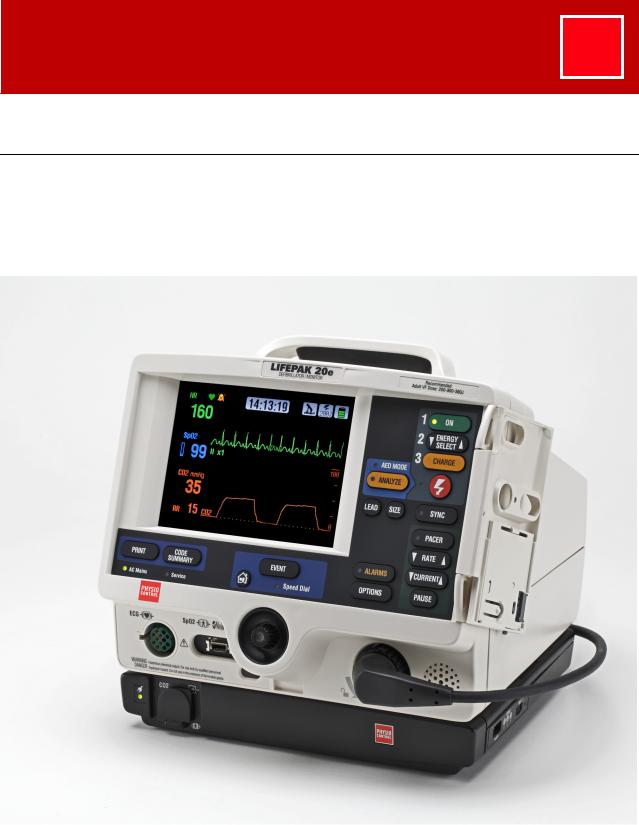
LIFEPAK® 20e DEFIBRILLATOR/MONITOR
Operating Instructions

LIFEPAK® 20e DEFIBRILLATOR/MONITOR
OPERATING INSTRUCTIONS

Important Information
!USA Rx Only
!USA Device Tracking
The U.S. Food and Drug Administration requires defibrillator manufacturers and distributors to track the location of their defibrillators. If the device is located somewhere other than the shipping address or the device has been sold, donated, lost, stolen, exported, destroyed, permanently retired from use, or if the device was not obtained directly from Physio-Control, please do one of the following: register the device at http://www.physio-control.com, call the device tracking coordinator at 1.800.426.4448, or use one of the postage-paid address change cards located in the back of this manual to update this vital tracking information.
Text Conventions
Throughout these operating instructions, special text characters are used to indicate labels, screen messages, and voice prompts:
•Operating control labels: CAPITAL LETTERS such as ON/OFF and SHOCK.
•Screen messages and voice prompts: CAPITAL ITALICIZED LETTERS such as CONNECT ELECTRODES.
Version History
These operating instructions describe LIFEPAK 20e defibrillator/monitor devices with software version 3202609-084 or later.
LIFEPAK, FAST-PATCH, DERMA-JEL, QUIK-LOOK, and QUIK-COMBO are registered trademarks of Physio-Control, Inc. ADAPTIV, CODE-STAT, CODE SUMMARY, REDI-PAK, and Shock Advisory System are trademarks of Physio-Control, Inc. Masimo and LNOP are registered trademarks of Masimo Corporation. Microstream, CapnoLine, and FilterLine are registered trademarks of Oridion Systems Ltd. The Oridion medical capnography in this product is covered by one or more of the following US patents: 6,428,483; 6,997,880; 6,437,316; 7,448,229; 7,726,954 and their foreign equivalents. Additional patent applications pending. EDGE System is a trademark of Ludlow Technical Products. Microsoft and Windows are registered trademarks of Microsoft Corporation. Specifications are subject to change without notice.
©2006-2013 Physio-Control, Inc.
Publication Date: 11/2013 |
3313187-007 |
|

CONTENTS
Preface
About Automated External Defibrillation ...................................................................... |
viii |
About Defibrillation Therapy .......................................................................................... |
ix |
About Noninvasive Pacing ............................................................................................. |
x |
About SpO2 Monitoring .................................................................................................. |
x |
About ECG Monitoring ................................................................................................... |
x |
About EtCO2 Monitoring ................................................................................................ |
xi |
1 Safety Information
Terms........................................................................................................................... |
1-2 |
General Warnings and Cautions.................................................................................. |
1-2 |
Symbols ....................................................................................................................... |
1-4 |
2 Basic Orientation
Introduction .................................................................................................................. |
2-2 |
Unpacking and Inspecting ........................................................................................... |
2-2 |
Controls, Indicators, and Connectors .......................................................................... |
2-3 |
Area 3.................................................................................................................... |
2-6 |
Area 4.................................................................................................................... |
2-8 |
Area 7.................................................................................................................. |
2-11 |
Changing Printer Paper....................................................................................... |
2-13 |
Back View............................................................................................................ |
2-14 |
Side View of CodeManagement Module ............................................................. |
2-15 |
Entering Patient Data................................................................................................. |
2-16 |
Setting Alarms ........................................................................................................... |
2-17 |
Managing Alarms....................................................................................................... |
2-19 |
Connecting to Power ................................................................................................. |
2-20 |
AC Operation....................................................................................................... |
2-20 |
LIFEPAK 20e Defibrillator/Monitor Operating Instructions |
iii |
©2006-2013 Physio-Control, Inc.

Battery Operation |
....................................................................................................... |
2-20 |
LIFEPAK 20e |
Defibrillator/Monitor Battery .......................................................... |
2-20 |
CodeManagement ......................................................................Module Battery |
2-23 |
|
3 Monitoring
Monitoring the ECG...................................................................................................... |
3-2 |
ECG Monitoring Warning....................................................................................... |
3-2 |
Selecting ECG Lead and Size ............................................................................... |
3-2 |
Adjusting the Systole Tone Volume....................................................................... |
3-3 |
Monitoring with the Patient ECG Cable ................................................................. |
3-5 |
Troubleshooting Tips for ECG Monitoring ............................................................. |
3-7 |
Monitoring SpO2 ...................................................................................................................................... |
3-9 |
SpO2 Warnings and Cautions................................................................................ |
3-9 |
When to Use a Pulse Oximeter ........................................................................... |
3-10 |
How a Pulse Oximeter Works.............................................................................. |
3-10 |
SpO2 Monitoring Considerations ......................................................................... |
3-11 |
SpO2 Monitoring Procedure................................................................................. |
3-12 |
SpO2 Waveform................................................................................................... |
3-12 |
SpO2 Volume....................................................................................................... |
3-12 |
Sensitivity............................................................................................................. |
3-13 |
Averaging Time.................................................................................................... |
3-13 |
Pulse Oximeter Sensors ...................................................................................... |
3-13 |
Cleaning............................................................................................................... |
3-13 |
Troubleshooting Tips for SpO2 ............................................................................ |
3-14 |
Monitoring EtCO2 .................................................................................................................................. |
3-16 |
EtCO2 Warnings and Cautions ............................................................................ |
3-16 |
How Capnography Works.................................................................................... |
3-17 |
EtCO2 Monitoring Waveform Analysis................................................................. |
3-17 |
EtCO2 Monitoring Procedure ............................................................................... |
3-18 |
CO2 Display ......................................................................................................... |
3-20 |
CO2 Alarms.......................................................................................................... |
3-20 |
CO2 Detection...................................................................................................... |
3-21 |
Cleaning............................................................................................................... |
3-21 |
Troubleshooting Tips for EtCO2........................................................................... |
3-22 |
|
|
4 Therapy |
|
General Therapy Warnings and Cautions.................................................................... |
4-2 |
Therapy Electrode and Standard Paddle Placement ................................................... |
4-3 |
Anterior-lateral Placement ..................................................................................... |
4-3 |
Anterior-posterior Placement ................................................................................. |
4-3 |
Special Placement Situations ................................................................................ |
4-4 |
Automated External Defibrillation................................................................................. |
4-5 |
AED Warnings ....................................................................................................... |
4-5 |
AED Setup ............................................................................................................. |
4-5 |
AED Procedure...................................................................................................... |
4-6 |
Special AED Setup Options................................................................................. |
4-10 |
Troubleshooting Tips for AED Mode.................................................................... |
4-13 |
Switching from AED to Manual Mode .................................................................. |
4-14 |
Manual Defibrillation................................................................................................... |
4-14 |
Manual Defibrillation Warnings ............................................................................ |
4-15 |
Impedance ........................................................................................................... |
4-15 |
Defibrillation Procedure ....................................................................................... |
4-16 |
CPR Metronome .................................................................................................. |
4-17 |
iv |
LIFEPAK 20e Defibrillator/Monitor Operating Instructions |

Synchronized Cardioversion Procedure.............................................................. |
4-18 |
Remote Synchronization Procedure.................................................................... |
4-20 |
Pediatric Defibrillation ................................................................................................ |
4-21 |
Pediatric Paddle Placement ................................................................................ |
4-21 |
Defibrillation Procedure ....................................................................................... |
4-22 |
Troubleshooting Tips for Defibrillation and Synchronized Cardioversion............ |
4-22 |
Noninvasive Pacing ................................................................................................... |
4-25 |
Noninvasive Pacing Warnings............................................................................. |
4-25 |
Demand and Nondemand Pacing ....................................................................... |
4-25 |
Noninvasive Pacing Procedure ........................................................................... |
4-26 |
Troubleshooting Tips for Noninvasive Pacing ..................................................... |
4-27 |
5 Paddle Accessory Options
Therapy Electrodes...................................................................................................... |
5-2 |
About Therapy Electrodes..................................................................................... |
5-2 |
Electrode Placement ............................................................................................. |
5-3 |
Cable Connection.................................................................................................. |
5-4 |
ECG Monitoring and Therapy Procedures ............................................................ |
5-4 |
Replacing and Removing Electrodes .................................................................... |
5-5 |
Testing................................................................................................................... |
5-6 |
Cleaning and Sterilizing......................................................................................... |
5-6 |
Standard Paddle Set (Optional)................................................................................... |
5-7 |
About the Standard Paddle Set............................................................................. |
5-7 |
Accessing the Pediatric Paddles ........................................................................... |
5-7 |
Replacing the Adult Paddle Attachment................................................................ |
5-8 |
Cleaning the Standard Paddle Set ........................................................................ |
5-8 |
Sterilizable Internal Defibrillation Paddles ................................................................... |
5-9 |
6 Data Management
Overview of Data Storage and Retrieval ..................................................................... |
6-2 |
Data Storage ......................................................................................................... |
6-2 |
Report Types......................................................................................................... |
6-2 |
Memory Capacity .................................................................................................. |
6-2 |
CODE SUMMARY Report ........................................................................................... |
6-2 |
Preamble ............................................................................................................... |
6-3 |
Event/Vital Signs Log ............................................................................................ |
6-3 |
Waveform Events .................................................................................................. |
6-4 |
CODE SUMMARY Format .................................................................................... |
6-5 |
Managing Archived Patient Records ........................................................................... |
6-7 |
Entering Archives Mode............................................................................................... |
6-7 |
Printing Archived Patient Reports................................................................................ |
6-7 |
Transmitting Archived Patient Records ....................................................................... |
6-9 |
Editing Archived Patient Records .............................................................................. |
6-10 |
Deleting Archived Patient Records ............................................................................ |
6-11 |
Overview of Connections for Transmitting Reports ................................................... |
6-12 |
Data Transfer from TrueCPR Device......................................................................... |
6-13 |
Troubleshooting Tips for Data Transmission ............................................................. |
6-14 |
7 Maintaining the Equipment
General Maintenance and Testing............................................................................... |
7-2 |
Maintenance and Testing Schedule ...................................................................... |
7-2 |
Daily Auto Test ...................................................................................................... |
7-3 |
User Test............................................................................................................... |
7-4 |
LIFEPAK 20e Defibrillator/Monitor Operating Instructions |
v |
©2006-2013 Physio-Control, Inc.

Cleaning................................................................................................................. |
7-5 |
Function Checks .................................................................................................... |
7-5 |
General Troubleshooting Tips ................................................................................... |
7-10 |
Service and Repair..................................................................................................... |
7-12 |
Product Recycling Information ................................................................................... |
7-12 |
Recycling Assistance........................................................................................... |
7-12 |
Preparation .......................................................................................................... |
7-12 |
Recycling of Disposable Electrodes .................................................................... |
7-12 |
Packaging ............................................................................................................ |
7-12 |
Warranty..................................................................................................................... |
7-12 |
Accessories, Supplies, and Training Tools ............................................................... |
7-13 |
8 Defining Setup Options
Setup Options .............................................................................................................. |
8-2 |
Print Configurations Before Service or Repair....................................................... |
8-2 |
Passcode Security ................................................................................................. |
8-2 |
Entering Setup Options ................................................................................................ |
8-3 |
General Setup Menu .................................................................................................... |
8-4 |
Manual Mode Setup Menu ........................................................................................... |
8-5 |
AED Mode Setup Menu ............................................................................................... |
8-7 |
CPR Metronome Setup Menu ...................................................................................... |
8-8 |
Pacing Setup Menu...................................................................................................... |
8-9 |
Monitoring Menu .......................................................................................................... |
8-9 |
Channels Setup Menu ........................................................................................... |
8-9 |
Waveform Sets Setup Menu................................................................................ |
8-10 |
CO2 Setup Menu ................................................................................................. |
8-10 |
Events Setup Menu.................................................................................................... |
8-10 |
Alarms Setup Menu.................................................................................................... |
8-11 |
Printer Setup Menu .................................................................................................... |
8-11 |
Auto Print Setup Menu......................................................................................... |
8-12 |
Clock Setup Menu...................................................................................................... |
8-12 |
Reset Defaults Setup Menu ....................................................................................... |
8-13 |
Print Defaults.............................................................................................................. |
8-13 |
Send Configuration Setup Menu ................................................................................ |
8-13 |
Set Passcodes Setup Menu....................................................................................... |
8-14 |
Service Mode ............................................................................................................. |
8-14 |
ASpecifications and Performance Characteristics
BClinical Summaries
CScreen Messages
DOperator’s Checklist
EShock Advisory System
FAbout cprMAX Technology
GDocking Station
HElectromagnetic Compatibility Guidance
Index
vi |
LIFEPAK 20e Defibrillator/Monitor Operating Instructions |

Preface
PREFACE
About Automated External Defibrillation |
page viii |
About Defibrillation Therapy |
ix |
About Noninvasive Pacing |
x |
About SpO2 Monitoring |
x |
About ECG Monitoring |
x |
About EtCO2 Monitoring |
xi |
|
|
LIFEPAK 20e Defibrillator/Monitor Operating Instructions |
vii |
©2006-2013 Physio-Control, Inc.

Preface
ABOUT AUTOMATED EXTERNAL DEFIBRILLATION
The following considerations and guidelines apply when using the LIFEPAK® 20e defibrillator/ monitor as an automated external defibrillator (AED).
Operator Considerations
The LIFEPAK 20e defibrillator/monitor, when in AED mode, is a semiautomatic defibrillator that uses a patented Shock Advisory System™. This software algorithm analyzes the patient’s electrocardiographic (ECG) rhythm and indicates whether or not it detects a shockable rhythm. The LIFEPAK 20e defibrillator/monitor in AED mode requires operator interaction to defibrillate the patient.
The LIFEPAK 20e defibrillator/monitor in AED mode is intended for use by personnel who are authorized by a physician/medical director and have, at a minimum, the following skills and training:
•CPR training.
•AED training equivalent to that recommended by the American Heart Association.
•Training in the use of the LIFEPAK 20e defibrillator/monitor in AED mode.
Indications
The AED mode is to be used only on patients in cardiopulmonary arrest. The patient must be unconscious, pulseless, and not breathing normally before using the defibrillator to analyze the patient’s ECG rhythm.
In AED mode, the LIFEPAK 20e defibrillator/monitor is not intended for use on pediatric patients less than 8 years old.
Contraindications
None known.
viii |
LIFEPAK 20e Defibrillator/Monitor Operating Instructions |

Preface
ABOUT DEFIBRILLATION THERAPY
Operator Considerations
A direct current defibrillator applies a brief, intense pulse of electricity to the heart muscle. The LIFEPAK 20e defibrillator/monitor delivers this energy through disposable electrodes, standard paddles or internal paddles applied to the patient’s chest.
Defibrillation is only one aspect of the medical care required to resuscitate a patient with a shockable ECG rhythm. Depending on the situation, other supportive measures may include:
•Cardiopulmonary resuscitation (CPR)
•Administration of supplemental oxygen
•Drug therapy
Successful resuscitation is related to the length of time between the onset of a heart rhythm that does not circulate blood (ventricular fibrillation, pulseless ventricular tachycardia) and defibrillation. The American Heart Association has identified the following as critical links in the chain of survival from cardiac arrest:
•Early access
•Early CPR by first responders or bystanders
•Early defibrillation
•Early advanced life support
The physiological state of the patient may affect the likelihood of successful defibrillation. Thus, failure to resuscitate a patient is not a reliable indicator of defibrillator performance. Patients will often exhibit a muscular response (such as jumping or twitching) during an energy transfer. The absence of such a response is not a reliable indicator of actual energy delivery or device performance.
Indications
Defibrillation is a recognized means of terminating certain potentially fatal arrhythmias, such as ventricular fibrillation and symptomatic ventricular tachycardia. Delivery of this energy in the synchronized mode is a method for treating atrial fibrillation, atrial flutter, paroxysmal supraventricular tachycardia and, in relatively stable patients, ventricular tachycardia.
Contraindications
Defibrillation is contraindicated in the treatment of Pulseless Electrical Activity (PEA) such as idioventricular or ventricular escape rhythms, and in the treatment of asystole.
Preface
LIFEPAK 20e Defibrillator/Monitor Operating Instructions |
ix |
©2006-2013 Physio-Control, Inc.

Preface
ABOUT NONINVASIVE PACING
A noninvasive pacemaker is a device that delivers an electrical stimulus to the heart, causing cardiac depolarization and myocardial contraction. The energy is delivered through large adhesive electrodes placed on the chest. In addition to noninvasive pacing, other supportive measures may be necessary.
Among other factors, it is recognized that successful pacing of a patient is related to the length of time between the onset of a dysrhythmia and the initiation of pacing. Rapid pacing and prompt follow-up care are essential. The physiologic state of the patient may affect the likelihood of successful pacing or of skeletal muscle activity. The failure to successfully pace a patient is not a reliable indicator of pacemaker performance. Similarly, the patient’s muscular response to pacing is not a reliable indicator of energy delivered. Refer to the booklet, Noninvasive Pacing: What You Should Know for further information.
Indications
Noninvasive pacing is indicated for symptomatic bradycardia in patients with a pulse.
Contraindications
Noninvasive pacing is contraindicated for the treatment of ventricular fibrillation and asystole.
ABOUT SPO2 MONITORING
A pulse oximeter is a noninvasive device that checks the saturation of oxygen in arterial blood (SpO2). It uses an optical sensor that directs light through the patient’s finger and then measures the received light with a detector. This received light is translated into a saturation percentage and is displayed as an SpO2 reading.
Indications
A pulse oximeter is indicated for use in any patient who is at risk of developing hypoxemia.
Contraindications
None known.
ABOUT ECG MONITORING
The ECG (electrocardiogram) is a recording of the electrical activity of the heart. ECG monitoring allows for identification and interpretation of cardiac rhythms or dysrhythmias and calculation of heart rate. The ECG is obtained by placing either electrodes or paddles on the patient and allows the heart’s electrical activity to be monitored and recorded.
x |
LIFEPAK 20e Defibrillator/Monitor Operating Instructions |

Preface
ABOUT ETCO2 MONITORING
The end-tidal carbon dioxide (EtCO2) monitor is a capnograph device that uses non-dispersive infrared spectroscopy to continuously measure the amount of CO2 during each breath and report the amount present at the end of exhalation (EtCO2). The sample is obtained by the side stream method and can be used with intubated or nonintubated patients. Respiration rate is also measured and displayed in breaths per minute.
The EtCO2 monitor is a tool to be used in addition to patient assessment. Care should be taken to assess the patient at all times; do not rely solely on the EtCO2 monitor.
Indications
EtCO2 monitoring is used to detect the level of expired CO2. It is used for monitoring breathing efficacy and treatment effectiveness in acute cardiopulmonary care, for example, to determine if adequate compressions are being performed during CPR or to rapidly detect whether an endotracheal tube has been placed successfully.
Contraindications
None known.
Preface
LIFEPAK 20e Defibrillator/Monitor Operating Instructions |
xi |
©2006-2013 Physio-Control, Inc.

SAFETY INFORMATION
Information Safety 1
This section provides important information to help you operate the LIFEPAK 20e defibrillator/ monitor. Familiarize yourself with all of these terms, warnings, and symbols.
Terms |
page 1-2 |
General Warnings and Cautions |
1-2 |
Symbols |
1-4 |
|
|
LIFEPAK 20e Defibrillator/Monitor Operating Instructions |
1-1 |
©2006-2013 Physio-Control, Inc.

Safety Information
TERMS
The following terms are used either in these operating instructions or on the LIFEPAK 20e defibrillator/monitor:
Danger: Immediate hazards that will result in serious personal injury or death.
Warning: Hazards or unsafe practices that may result in serious personal injury or death.
Caution: Hazards or unsafe practices that may result in minor personal injury, product damage, or property damage.
GENERAL WARNINGS AND CAUTIONS
The following are general warning and caution statements. Other specific warnings and cautions are provided as needed in other sections of these operating instructions.
WARNINGS!
Shock hazard.
The defibrillator delivers up to 360 J of electrical energy. Unless properly used as described in these operating instructions, this electrical energy may cause serious injury or death. Do not attempt to operate this device unless thoroughly familiar with these operating instructions and the function of all controls, indicators, connectors, and accessories.
Shock hazard.
Do not disassemble the defibrillator. It contains no operator serviceable components and dangerous high voltages may be present. Contact authorized service personnel for repair.
Shock hazard.
To avoid the risk of electrical shock, this equipment must only be connected to a supply mains with protective earth.
Shock or fire hazard.
Do not immerse any portion of this defibrillator in water or other fluids. Avoid spilling any fluids on defibrillator or accessories. Spilled liquids may cause the defibrillator and accessories to perform inaccurately or fail. Do not clean with ketones or other flammable agents. Do not autoclave or sterilize this defibrillator or accessories unless otherwise specified.
Possible fire or explosion.
Do not use this device in the presence of flammable gases or anesthetics. Use care when operating this device close to oxygen sources (such as bag-valve-mask devices or ventilator tubing). Turn off gas source or move source away from patient during defibrillation.
Possible electrical interference with device performance.
Equipment operating in close proximity could emit strong electromagnetic or radio frequency disturbances that could cause electromagnetic interference (EMI) and affect the performance of this defibrillator. EMI may result in improper defibrillator operation, distorted ECG, failure to detect a shockable rhythm, or cessation of pacing. Avoid operating the defibrillator near cauterizers, diathermy equipment, cellular phones, or other portable and mobile RF communications equipment. Maintain equipment separation of at least 1.2 m (4 ft) and do not rapidly key EMS radios on and off. Contact a technical support representative if assistance is required.
1-2 |
LIFEPAK 20e Defibrillator/Monitor Operating Instructions |

Safety Information
WARNINGS! (CONTINUED)
Possible electrical interference.
Using cables, electrodes, or accessories not specified for use with this device may result in increased emissions or decreased resistance to electromagnetic interference which could affect the performance of this device or of equipment in close proximity. Use only parts and accessories specified in these operating instructions.
Possible electrical interference.
This defibrillator may cause electromagnetic interference (EMI) especially during charge and energy transfers. EMI may affect the performance of equipment operating in close proximity. Verify the effects of defibrillator discharge on other equipment prior to using defibrillator in an emergency situation, if possible.
Possible electrical interference.
This defibrillator should not be used adjacent to or stacked with other equipment. If adjacent or stacked use is necessary, the defibrillator should be observed to verify normal operation in the configuration in which it will be used.
Possible defibrillator shutdown.
When operating on battery power, adhere to battery maintenance and replacement intervals discussed in the Battery Performance and Life section to prevent possible defibrillator shutdown. If the defibrillator shuts down without warning, or if a LOW BATTERY: CONNECT TO AC POWER message appears on the monitor screen, immediately connect the AC power cord to an outlet.
Possible device failure.
Do not modify the defibrillator or CodeManagement Module.
Possible improper defibrillator performance.
Changing factory default settings will change the behavior of the device. Changes to the default settings must only be made by authorized personnel.
Possible improper defibrillator performance.
Using other manufacturers’ cables, electrodes, or batteries may cause the device to perform improperly and invalidates the safety agency certification. Use only the accessories specified in these operating instructions.
Possible failure to detect an out of range condition.
Reselecting QUICK SET will reset the alarm limits around the patient’s current vital sign values. This may be outside the safe range for the patient.
Safety risk and possible equipment damage.
MR unsafe: keep the defibrillator away from magnetic resonance imaging (MRI) equipment.
Information Safety 1
LIFEPAK 20e Defibrillator/Monitor Operating Instructions |
1-3 |
©2006-2013 Physio-Control, Inc.
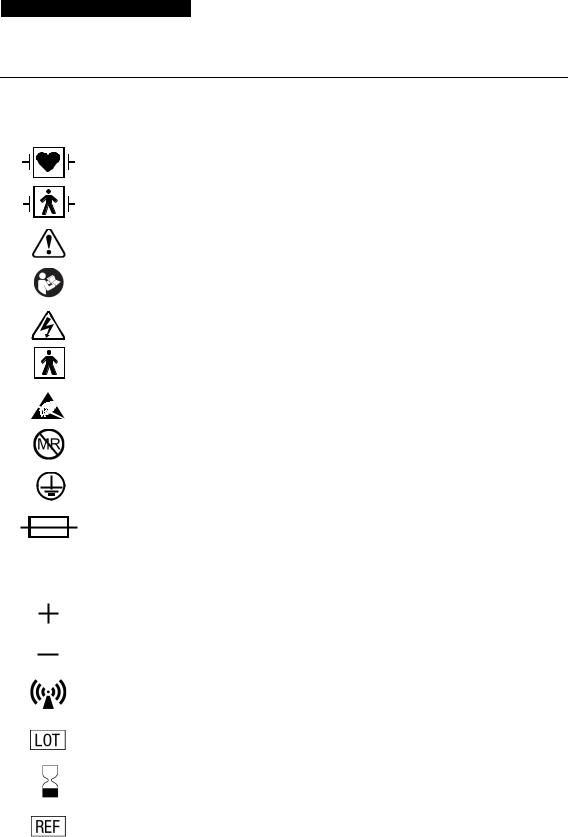
Safety Information
SYMBOLS
The symbols below may be found in these operating instructions or on various configurations of LIFEPAK 20e defibrillator/monitor and accessories:
Defibrillation-proof type CF terminal
Defibrillation protected, type BF patient connection
Attention, consult accompanying documents
Attention, consult accompanying documents. (Symbol has blue background and graphical symbol is white.)
Warning, high voltage
Type BF patient connection
Static sensitive device (SSD)
MR unsafe: keep away from magnetic resonance imaging (MRI) equipment
Safety ground. Protective earth connection
Fuse
Equipotential connector
Positive terminal
Negative terminal
Device includes RF transmitter
Lot number (batch code): yyww or yymmdd
Use by date shown: yyyy-mm-dd
Reorder number
 YYYY Date of manufacture
YYYY Date of manufacture
1-4 |
LIFEPAK 20e Defibrillator/Monitor Operating Instructions |

Safety Information
Single use only
Indoor use only
Alarm on
Alarm off
VF/VT alarm on
VF/VT alarm silenced
Greater than
Less than
J Joules
|
Adult defibrillation paddle |
|
Infant defibrillation paddle |
|
Home screen button |
|
Battery status indicator (refer to page 2-21) |
|
Heart rate/pulse rate indicator |
(x) |
Shock count (x) on screen |
Mark of conformity to applicable European Directives
Canadian Standards Association certification for Canada and the United States
Recognized component mark for Canada and the United States
LIFEPAK 20e Defibrillator/Monitor Operating Instructions |
1-5 |
©2006-2013 Physio-Control, Inc.
Information Safety 1

Safety Information
Mark of conformity to ACA standards
DC voltage
AC voltage
On (power: connection to the AC Mains)
Off (power: disconnection from the AC Mains)
Power on/off
AC power indicator (CodeManagement Module only)
[signal] Input
[signal] Output
CO2 Input
CO2 Exhaust
This end up
Fragile/breakable
Handle with care
Protect from water
Recommended storage temperature 5° to 45°C (41° to 113°F). Storage at extreme temperatures of -20° or 60°C (-4° or 140°F) is limited to seven days. If storage at these temperatures exceeds one week, the electrode shelf-life is reduced.
Recycle this item
Do not dispose of this product in the unsorted municipal waste stream. Dispose of this product according to local regulations. See www.physio-control.com/recycling for instructions on disposing of this product.
System connector/Data in
1-6 |
LIFEPAK 20e Defibrillator/Monitor Operating Instructions |
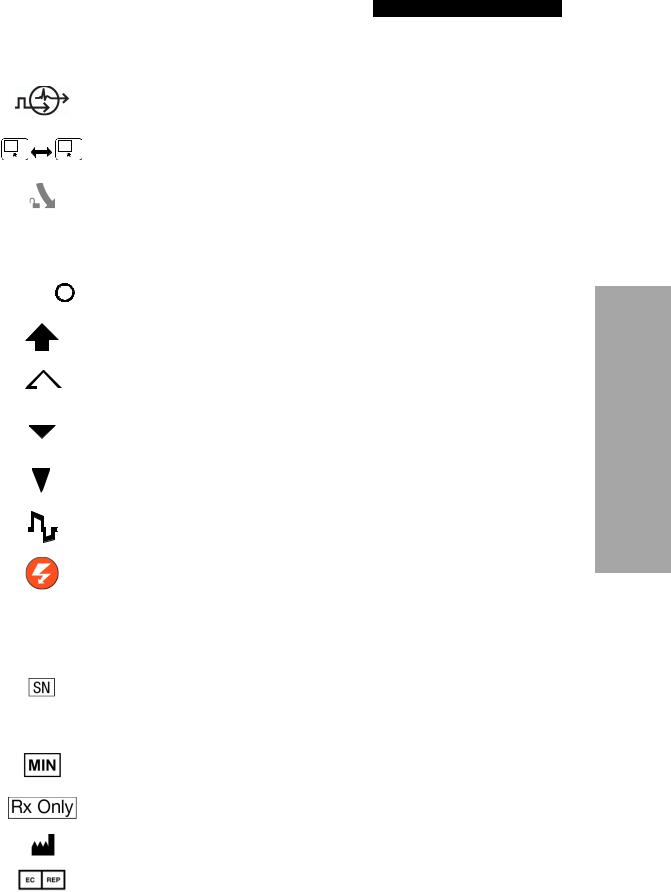
Safety Information
|
|
|
|
|
|
|
|
|
|
|
|
|
Sync in/ECG out |
|
|
|
|
|
|
|
|
|
|
|
|
|
LIFEPAK 20e defibrillator/monitor to LIFEPAK 20e defibrillator/monitor cable |
|
|
|
|
|
|
|
|
|
|
|
|||
|
|
|
|
|
|
|
|
|
|
|
|
|
(refer to Send Configuration Setup Menu, page 8-13) |
|
|
|
|
|
|
|
|
|
|
|
|||
|
|
|
|
|
|
|
|
|
|
|
|
||
|
|
|
|
|
|
|
|
|
|
|
|
|
|
|
|
|
|
|
|
|
|
|
|
|
|
|
Turn counterclockwise to unlock |
|
|
|
|
|
|
|
|
|
|
|
|
|
Switch on |
|
|
|
|
|
|
|
|
|
|
|
|
|
|
|
|
|
|
|
|
|
|
|
|
|
|
|
|
|
|
|
|
|
|
|
|
|
|
|
|
|
Switch off |
|
|
|
|
|
|
|
|
|
|
|
|
|
|
|
|
|
|
|
|
|
|
|
|
|
|
|
|
|
|
|
|
|
|
|
|
|
|
|
|
|
Pace arrow, noninvasive pacing |
|
|
|
|
|
|
|
|
|
|
|
|
|
|
|
|
|
|
|
|
|
|
|
|
|
|
|
Pace arrow, internal pacing |
|
|
|
|
|
|
|
|
|
|
|
|
|
|
|
|
|
|
|
|
|
|
|
|
|
|
|
R-wave sense marker |
|
|
|
|
|
|
|
|
|
|
|
|
|
|
|
|
|
|
|
|
|
|
|
|
|
|
|
Event marker |
|
|
|
|
|
|
|
|
|
|
|
|
|
Biphasic defibrillation shock |
|
|
|
|
|
|
|
|
|
|
|
|
|
Shock button |
|
|
|
|
|
|
|
|
For USA audiences only |
|||||
|
|
|
|
|
!USA |
|
|
||||||
|
|
|
|
|
|
|
|
|
|||||
|
|
|
|
|
IPx1 |
|
|
Protected from dripping water per IEC 60529 |
|||||
|
|
|
|
|
|
|
|
|
|
|
|
|
Serial number |
|
|
|
|
|
|
|
|
Catalog number used for placing orders |
|||||
|
|
|
|
|
CAT |
|
|
||||||
|
|
|
|
|
|
|
|
|
|
|
|
|
Manufacturer’s Identification Number (part number) |
|
|
|
|
|
|
|
|
|
|
|
|
|
Federal law restricts this device to sale by or on the order of a physician |
|
|
|
|
|
|
|
|
|
|
|
|
|
Manufacturer |
|
|
|
|
|
|
|
|
|
|
|
|
|
Authorized EC representative |
LIFEPAK 20e Defibrillator/Monitor Operating Instructions |
1-7 |
©2006-2013 Physio-Control, Inc.
Information Safety 1

BASIC ORIENTATION
This section provides a basic orientation to the LIFEPAK 20e defibrillator/monitor.
Introduction |
page 2-2 |
Unpacking and Inspecting |
2-2 |
Controls, Indicators, and Connectors |
2-3 |
Entering Patient Data |
2-16 |
Setting Alarms |
2-17 |
Managing Alarms |
2-19 |
Connecting to Power |
2-20 |
|
|
Orientation Basic 2
LIFEPAK 20e Defibrillator/Monitor Operating Instructions |
2-1 |
©2006-2013 Physio-Control, Inc.

Basic Orientation
INTRODUCTION
The LIFEPAK 20e defibrillator/monitor with enhanced battery technology is an acute cardiac care response system intended for use by authorized healthcare providers in hospital and clinic settings.
The LIFEPAK 20e defibrillator/monitor offers the following optional features:
•Semiautomatic defibrillator
•Noninvasive pacemaker
•Pulse oximeter
•Paddle accessories
•End-tidal CO2 monitor
•Data transmission
Note: These operating instructions include information and procedures related to all features of the LIFEPAK 20e defibrillator/monitor and the CodeManagement Module for use with the LIFEPAK 20e defibrillator/monitor. Your LIFEPAK 20e defibrillator/monitor may not have all of these features. For more information, contact your Physio-Control representative or call the number listed on the back cover of these operating instructions.
The LIFEPAK 20e defibrillator/monitor is available only with the biphasic defibrillation waveform. For a description of the defibrillation waveform, refer to Appendix A.
The LIFEPAK 20e defibrillator/monitor uses QUIK-COMBO® pacing/defibrillation/ECG electrodes or FAST-PATCH® disposable defibrillation/ECG electrodes for ECG monitoring and patient therapy. The therapy cable connects the QUIK-COMBO or FAST-PATCH electrodes to the defibrillator. For more information about QUIK-COMBO or FAST-PATCH electrodes, refer to Section 3 of these operating instructions.
The standard paddle set is an accessory for the LIFEPAK 20e defibrillator/monitor and includes adult and pediatric defibrillator (hard) paddles. The standard paddles can be used for QUIK-LOOK® ECG monitoring, defibrillation, and synchronized cardioversion therapies. When using standard paddles, a conductive interface designed for defibrillation, such as defibrillation gel or gel pads, must be used between the paddle electrode surface and the skin.
The adult standard paddles can be used for any pediatric patient weighing approximately 10 kg (22 lb) or more as long as the paddles fit completely on the chest and there is at least 2.5 cm (1 in.) of space between the paddle electrodes. Pediatric paddles should be used for patients weighing 10 kg (22 lb) or less or those whose chests are too small to accommodate the adult paddles.
Optional internal paddles are also available.
For more information about using paddle accessories, refer to Section 5 of these operating instructions.
UNPACKING AND INSPECTING
After you have removed the LIFEPAK 20e defibrillator/monitor from the shipping container, make sure you have all the required supplies and accessories including cables and ECG paper. Examine the defibrillator and all accessories for any sign of damage that may have occurred during shipping. If possible, save the shipping container and foam inserts in case you have to ship the defibrillator at a later date.
2-2 |
LIFEPAK 20e Defibrillator/Monitor Operating Instructions |
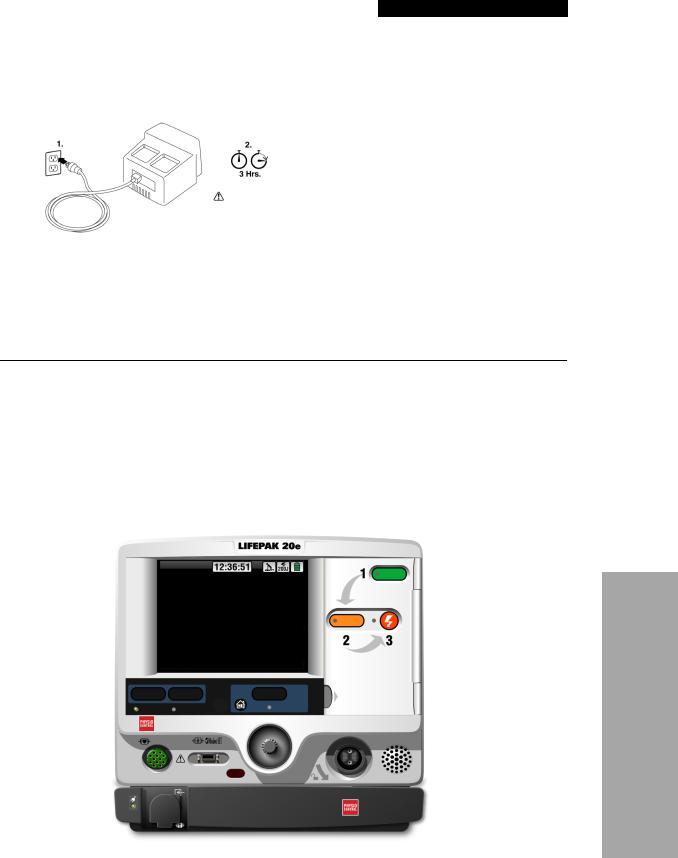
Basic Orientation
Note the label located to the right of the screen (Figure 2-1). Before the defibrillator/monitor’s first use, plug the power cord into an AC outlet for 3 hours to charge the internal battery.
Figure 2-1 Initial Battery Charge
If you purchased the CodeManagement Module, you will need to connect it to the LIFEPAK 20e defibrillator/monitor. Refer to the Installation Instructions provided with the CodeManagement Module for more information.
CONTROLS, INDICATORS, AND CONNECTORS
The following figures provide a brief description of the controls, indicators, and connectors for the LIFEPAK 20e defibrillator/monitor and CodeManagement Module. Figure 2-2 shows the front view of the LIFEPAK 20e defibrillator/monitor and Figure 2-3 shows the front view divided into seven areas. Figure 2-4 through Figure 2-15 show details of each area. Figure 2-16 and
Figure 2-17 show back views of the defibrillator with and without the CodeManagement Module. Additional information about areas 3, 4, and 7 follow the applicable figures. The light emitting diode (LED) illuminates (turns on) indicating when the corresponding function is active. For example, the ANALYZE button LED is on when the advisory function is active.
DEFIBRILLATOR / MONITOR
AED Mode
Analyzing Now--Stand Clear
CODE |
EVENT |
||
SUMMARY |
|||
|
|
||
AC Mains |
Service |
Speed Dial |
|
|
ECG SpO2
WARNING Hazardous electrical output. For use only by qualified personnel.
DANGER Explosion hazard. Do not use in the presence of flammable gases.
CO2
Recommended
Adult VF Dose: XXX-XXX-XXXJ
ON
ANALYZE
Figure 2-2 Front View with Door and CodeManagement Module
LIFEPAK 20e Defibrillator/Monitor Operating Instructions |
2-3 |
©2006-2013 Physio-Control, Inc.
Orientation Basic 2
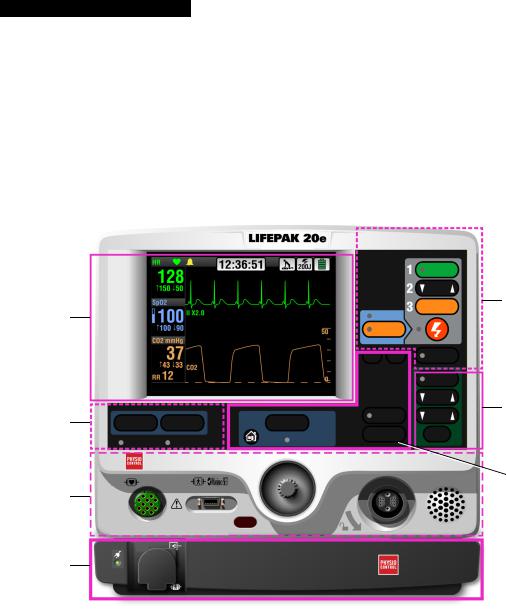
Basic Orientation
The door on the LIFEPAK 20e defibrillator/monitor hides the manual defibrillation and noninvasive pacing buttons. When the door is closed, the appearance and operation of the device is simplified for the automated external defibrillator (AED) user.
To enter manual mode, press the MANUAL button located on the lower left corner of the door. This opens the door and automatically takes the device out of AED mode and allows access to manual mode defibrillation and pacing. After entering manual mode, closing the door does not affect operation.
Area 7
Area 5
Area 4
Area 6
|
Recommended |
DEFIBRILLATOR / MONITOR |
Adult VF Dose: XXX-XXX-XXXJ |
|
|
|
ON |
|
|
|
ENERGY |
|
|
|
SELECT |
|
|
|
CHARGE |
|
|
AED MODE |
|
|
|
ANALYZE |
|
|
|
LEAD SIZE |
SYNC |
|
|
|
PACER |
|
|
|
RATE |
|
CODE |
ALARMS |
CURRENT |
EVENT |
|
||
SUMMARY |
|
||
|
OPTIONS |
PAUSE |
|
|
|
||
AC Mains |
Service |
Speed Dial |
|
|
|
||
ECG |
SpO2 |
|
|
WARNING Hazardous electrical output. For use only by qualified personnel.
DANGER Explosion hazard. Do not use in the presence of flammable gases.
CO2
Area 1
Area 2
 Area 3
Area 3
Figure 2-3 Front View without Door and with CodeManagement Module
2-4 |
LIFEPAK 20e Defibrillator/Monitor Operating Instructions |
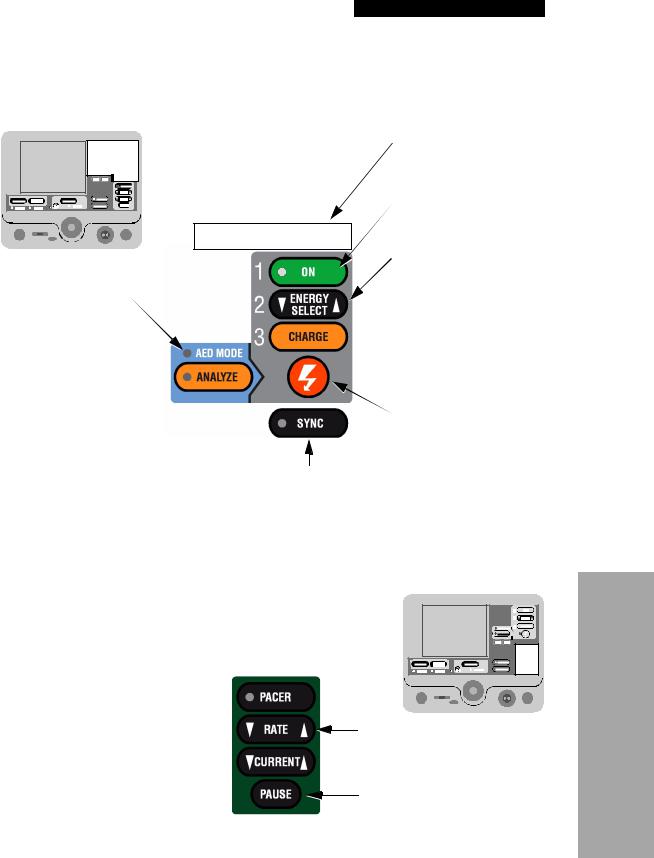
Basic Orientation
Area 1
1 |
Adult Ventricular |
Fibrillation Energy Label |
|
Refer to page F-2. |
|
|
ON |
|
Switches power on or off. |
AED MODE
LED illuminates when
AED mode is active.
Refer to page 4-5.
ANALYZE 
Activates Shock Advisory System (SAS).
Refer to page 4-7.
Recommended
Adult VF Dose: xxx-xxx-xxxJ
ENERGY SELECT
Selects energy levels in manual mode.
Refer to page 4-14.
 CHARGE
CHARGE
Charges the defibrillator in manual mode.
Refer to page 4-14.
 SHOCK
SHOCK
Discharges defibrillator energy to the patient. Refer to page 4-16.
SYNC
Activates sychronized mode.
Refer to page 4-18.
Figure 2-4 Area 1
Area 2
PACER 

Activates the pacing function. Refer to page 4-25.
CURRENT 

Adjusts pacing current.
Refer to page 4-25.
2 |
RATE
Selects pacing rate.
Refer to page 4-25.
PAUSE
Temporarily slows pacing rate. Refer to page 4-25.
Figure 2-5 Area 2
LIFEPAK 20e Defibrillator/Monitor Operating Instructions |
2-5 |
©2006-2013 Physio-Control, Inc.
Orientation Basic 2

Basic Orientation
Area 3
EVENT
Activates userdefined events.
Refer to page 2-6.
HOME SCREEN
Returns immediately to Home Screen.
Refer to page 2-6.
Figure 2-6 Area 3
3 |
LEAD
Changes ECG lead.
Refer to page 3-2.
SIZE
Changes ECG size. Refer to page 3-2.
ALARMS
Activates and silences alarms. Refer to page 2-17.
 OPTIONS
OPTIONS
Accesses optional functions.
Refer to page 2-7.
LED
Illuminates when the Speed Dial is active.
Refer to page 2-8.
Area 3
The following paragraphs provide additional information about the controls shown in "Area 3," page 2-6.
Home Screen
The home screen is the background screen that displays during ECG monitoring. Pressing HOME SCREEN returns you to the home screen from any menu screen or overlay, except during AED analysis or during manual defibrillation charging and shocking.
Event
After pressing EVENT, the screen displays the following overlay.
Use the Speed Dial to scroll through and select menu choices.
Generic is automatically selected when EVENT is pressed and no other selection is made. The selected event and time stamp appear in the message/status area on the screen. Events are printed in the CODE SUMMARY™ Event Log. Refer to page 8-10 for information about configuring events.
2-6 |
LIFEPAK 20e Defibrillator/Monitor Operating Instructions |

Basic Orientation
Options
After pressing OPTIONS, the screen displays the overlay shown in Figure 2-7. Use the Speed Dial to scroll through and select menu choices.
PATIENT
Enters patient name, patient ID, location, age, and sex
PACING
Selects demand or nondemand pacing
Selects internal pacer detection on/off
PRINT
Selects printer report, format, and mode for printing a current patient report
ARCHIVES 
Accesses archived patient records.
Refer to page 6-7.
Figure 2-7 Options
 DATE/TIME
DATE/TIME
Sets the date and time. For changes to take effect, cycle power.
 ALARM VOLUME
ALARM VOLUME
Adjusts volume for alarms, tones, and voice prompts.
 USER TEST
USER TEST
Initiates user test.
Refer to page 7-4.
Alarms
Refer to page 2-17 for information about setting alarms.
Speed Dial LED
The indicator LED for the Speed Dial illuminates when the Speed Dial is active.
Area 4
ECG CABLE PORT |
|
to page 3-5. |
SPEED DIAL |
|
Scrolls through and selects |
Refer to warning, page 2-15. |
menu items. Refer to this page. |
|
4 |
Orientation Basic 2
SpO2 CABLE PORT |
IrDA PORT |
THERAPY CABLE |
SPEAKER |
Refer to page 3-11. |
Refer to page 6-12. |
PORT |
|
Refer to page 2-8. |
|
||
|
|
|
|
Figure 2-8 Area 4 |
|
|
|
LIFEPAK 20e Defibrillator/Monitor Operating Instructions |
2-7 |
©2006-2013 Physio-Control, Inc.

Basic Orientation
Area 4
The following paragraphs provide additional information about the Speed Dial and the therapy cable connector shown in Area 4.
Speed Dial
Use the Speed Dial to scroll through and select the desired menu item either while viewing the monitor screen or while in Options mode. Press the Speed Dial to activate the highlighted menu item. Default menu items are highlighted with a gray background; after a menu item is selected, the background is black.
Therapy Cable Connector
WARNING!
Possible equipment damage and inability to deliver therapy.
To protect the therapy cable connector from damage or contamination, keep the therapy cable connected to the defibrillator at all times.
Connecting the Therapy Cable
To connect a therapy cable connector to the therapy cable port:
1Orient the therapy cable so that the arrow is on top with the cable angled to the right (refer to Figure 2-9).
2Insert the therapy cable into the therapy cable connector on the defibrillator until a “click” is sensed.
3Pull gently on the locking ring to check that the cable is locked in place.
Disconnecting the Therapy Cable
To disconnect a therapy cable connector from the therapy cable port:
1Rotate the locking ring on the therapy cable in the direction of the arrow (counterclockwise) until it stops (refer to Figure 2-10).
2Gently pull out the cable connector.
 Locking Ring
Locking Ring
|
|
|
|
|
|
|
|
|
|
|
|
|
|
|
|
|
|
|
|
|
|
|
|
|
|
|
|
|
|
|
|
|
|
|
|
|
|
|
|
|
|
|
|
|
|
|
|
|
|
|
|
|
|
|
|
|
|
|
|
|
|
|
|
|
|
|
|
|
|
|
|
|
|
|
|
|
|
|
|
|
|
|
|
|
|
|
|
|
|
Figure 2-9 Therapy Cable Orientation |
Figure 2-10 Disconnecting the Therapy Cable |
||||||||||||||||
2-8 |
LIFEPAK 20e Defibrillator/Monitor Operating Instructions |
